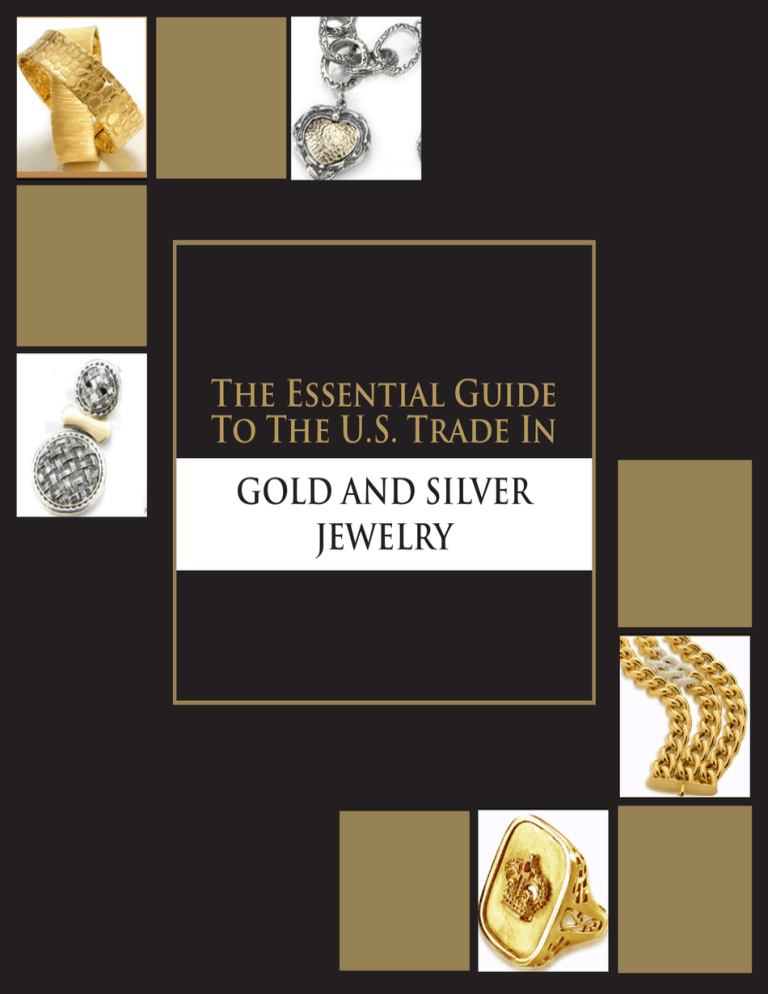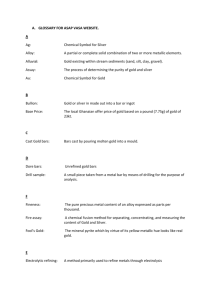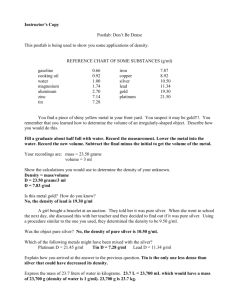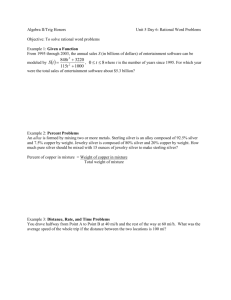The Essential Guide To The US Trade In
advertisement

The Essential Guide To The U.S. Trade In Gold And Silver Jewelry The Essential Guide To The U.S. Trade In Gold And Silver Jewelry CONTENTS 3 Introduction The Governing Legal Standards 4 To Stamp or Not - Gold and Silver 5 gold 8 Silver & alternative metals 9 2 gold stamping law jvc (jewelers Vigilance committee) summary INTRODUCTION The Jewelers Vigilance Committee is committed to provide a guidance tool for the trade on the subject of silver and gold precious metal articles. The laws and regulations that govern the manufacture and sale of industry products made with silver and gold are well established. Some of these regulations and laws go back to the beginning of the 20th century. The intention of this brochure is to ensure a greater understanding of these laws so that they can be properly applied to the trade practice in this area and, therefore, provide clear, accurate consumer information. New combinations and alloys of gold, silver and gold and other gold plated products are being developed for use in jewelry in this increasingly technological world. The application of the law to these products is essential to ensure consumer confidence in these products. This publication can be used as a guide to achieve a greater understanding of the legal requirements for identifying, marking and marketing these products. The information and guidance contained in this publication is not meant to be any form of legal advice. These standards described in this brochure do not apply to products made of metals that are used in the manufacture of costume jewelry. THE GOVERNING LEGAL STANDARDS The legal standards that apply to the manufacture, sale and advertising of jewelry made of silver or gold are contained in three government regulations. First, The National Gold and Silver Stamping Act is a federal law that was enacted in 1905. Violations of this law carry sanctions that include forfeiture, civil and criminal monetary penalties, and even jail! This statue addresses standards for fineness of gold and silver, rules pertaining to the making and marking of gold and silver objects and provides for law suits that can be brought by competitors and jewelry trade associations for violations of its provisions. The Federal Trade Commission Guides for the Jewelry, Precious Metal and Pewter Industries was published in its current form in 1996. These guidelines establish the standards the FTC will apply to claims and representations at all levels of the trade about “industry products” (jewelry and other objects) regarding any material aspect of the product. This includes labeling, promotional material, and all other forms of marketing, including advertising. Violations of these standards can lead to a FTC civil enforcement action that can impose both fines and injunctive relief. FTC guidance standards are fully subject to the National Gold and Silver Stamping Act. 3 Voluntary Product Standard (VPS) PS 68-76 was made effective in 1976. This standard was published by the US Department of Commerce, and reflects the accepted trade practice in the marking of articles made only of silver in combination with gold, either visually distinguishable or not, and includes articles where the gold fully covers the base. Violations of these standards are a matter of inconsistency with accepted trade practice. The guidance contained in this publication is based on JVC’s interpretation of three regulatory systems as they act in combination: The National Gold and Silver Stamping Act, the FTC Guides and the Voluntary Product Standard PS 68-76. This guidance is not intended as any form of legal advice. TO STAMP OR NOT – Gold and Silver Many people in the jewelry industry believe that fineness of precious metal must be stamped on a jewelry item made of gold or silver. This is certainly the case in many jurisdictions outside the US. But in the US, you are required to identify the fineness of the quality of the precious metal, but you do not need to stamp it on the item itself. You can identify it on the invoice, on a hangtag, or on other descriptive material accompanying the piece. If you do choose to quality stamp the jewelry item made of gold or silver, the law requires that you place a federally registered trademark in close proximity to the quality stamp. This has the effect of providing assurance to the purchaser that the item’s precious metal quality is guaranteed by the entity that stamps the item. The manufacturer’s duly registered trademark is usually stamped on the product - or the retailer can apply a registered 4 stamp. (It would be wise to acquire the manufacturer’s permission to apply a stamp other than the maker’s.) Whoever’s stamp is applied to the item will take responsibility and liability for the quality of the metal represented by the quality stamp. gold a) Gold alloy Sellers of items composed of gold alloys must identify the karat quality of the gold in the item. To use the word “Gold” without qualification means the product is 24-karat gold throughout. The minimum fineness for gold in the US is 10 karat. Anything that is less than 10 karat gold cannot be described as gold, even with the karat designation – it is a pretty yellow metal – but it is not gold! In the US, manufacturers are permitted a 3/1,000ths ppt (parts per thousand) tolerance for the gold content in jewelry as described in the gold chart. If the jewelry you are assaying contains solder, the tolerance for karat gold products is 7/1000ths ppt. Typically, jewelry items for sale in the US are 10, 14, 18 and 22 karat. Karat Gold Content Tolerance 10K 14K 18K 24K 41.67% 58.33% 75.00% 99.95% 0.300 0.300 0.300 0.300 b) Mechanical Application of Gold: Gold Filled, Rolled Gold Plate, Gold Overlay Gold Filled*, Gold Overlay Karat Gold 1/10 14K 1/20 14K 1/20 12K 1/20 10K Minimum 5.53 % 2.62 % 2.20 % 1.78 % Rolled Gold Plate, Gold Overlay 1/40 10K 1.041% 0.300 0.740% 1/40 14K 1.458% 0.300 1.160% *When the karat gold constitutes at least 1/20th of the weight of the metal in the entire article. When a layer of gold is affixed on all surfaces by any mechanical means, and the weight of the gold is a minimum of 1/20th of the total weight of the metal in the article, it may be marked “Gold Filled.” The quality of the gold used is typically 10, 12 or 14 karat gold. The karat quality of the gold used must be identified. Gold items that meet the 1/20th requirements may be identified as “Gold Filled” (GF), “Gold Overlay” (GO) or “Rolled Gold Plate” (RGP). Minimum 41.37% 58.03% 74.70% 99.65% Tolerance 5.83 % 0.300 2.92 % 0.300 2.50 % 0.300 2.08 % 0.300 Karat Solder Minimum Karat Gold 9.93K 13.93K 17.93K 23.92K 0.7% 0.7% 0.7% 0.7% 40.97% 57.63% 74.30% 99.25% 9.83K 3.83K 17.83K 23.82K 5 If the weight of the gold is less than 1/20th but a minimum of 1/40th of the total weight of the metal in the article, the terms “Gold Overlay” and “Rolled Gold Plate” may be used when the karat fineness is preceded by a fraction accurately disclosing the weight of the gold. (example, “1/40th 12kt R.G.P”, “1/40th 10kt Gold Overlay”.) c) Gold Sheathing Gold Plating Gold Plate Plating Thickness > 20 Micro-inch (>0.5 Micron) Gold Wash/Flashed< 7 Micro-inch (<0.175 Micron) Gold Electro Plate > 7 Micro-inch (>0.175 Micron) Heavy Au E.P. > 100 Micro-inch (>2.5 Microns) An article of jewelry is gold plated when gold is electroplated or mechanically coated with a minimum thickness of 1/2 micron (20 millionths of an inch ) of fine gold. The quality of the gold used is typically 10, 12, 14 karat. The karat quality of the gold plate must be disclosed it can be described as “12 K Gold Plate” or “2µ 12K.G.P. for an item plated with 2 microns of 12 karat gold.) When the minimum thickness applied is 0.175 micron (or approximately 7 millionths of an inch) of fine gold identify the product as “Gold Electroplate,” “Gold Electroplated” or “G.E.P.”. When the electroplating meets minimum fineness but not the minimum thickness stated above, identify the product as “Gold Flashed” or “Gold Washed”. When the electroplating meets the minimum fineness stated above and a minimum thickness equivalent to 2 ½ microns (or approximately 100 millionths of an inch) of fine gold, you may identify 6 the marking or description as “Heavy Gold Electroplate,” “Heavy Gold Electroplated” or “H.G.E.”. It is unfair or deceptive to use the terms “Gold Over…” “Gold Covering,” “Gold Coated,” or any such term to describe or qualify a gold item that has been plated, washed or flashed with a minimum fineness of 10K gold. NOTE: Hollow center – if a product is hollow in the center, this fact must be disclosed, either as “Gold – Hollow Center” or “Gold Tubing.” The karat quality of the gold used must also be identified, ie. “14K Gold Tubing”. d) Vermeil An article of jewelry is described as “vermeil” when there is a coating of gold over sterling silver, that is of substantial thickness. The coating must be at least 2 ½ microns (approximately 100 millionths of an inch) of fine gold. The quality of the gold used to coat over the silver is typically 10, 12 or 14 karat gold. The karat quality of the gold can be disclosed. e) Combination Gold and Silver These marks apply only to articles made of gold and silver and no other metal in quantities that meet the definition of precious metal, that is, 10 karat gold or better: NOTE: Examples of fractions recognized as accepted markings for articles of silver in combination with gold by this standard are: 1/2, 1/ 3, 1/ 4,1/5, 1/6, 1/7, 1/8, 1/9, 1/10, 1/15 and 1/20 1. Indistinguishable: If gold and silver are used in one article (alloyed or not), and are not visually distinguishable, you must disclose the amount of gold used. The quality mark must state “sterling silver + 10Kgold” preceded by a fraction representing the proportion of the weight of the gold to the entire weight of the metal in the article. The karat quality of the gold must also be disclosed. For example, an article made of 14 karat white gold and silver should be marked “Sterling and 1/5 14K.” Traditionally, the fraction follows the sterling mark except where the gold content is ½ or more of the weight of the article. So, the mark could be: “½ 10K + Sterling” if the gold part of the item is ½ or more of the total weight of the article. Gold completely covering base metal is plated gold, and the plating rules apply. 2. Distinguishable: When the two precious metals can be distinguished (yellow and white) the two metals can be marked similarly. However, the yellow gold portion must be gold throughout. Examples of marks are: “Sterling + 14K” and “18K + 925.” Traditionally, the silver is identified first except where the gold content is 1/2 or more of the entire weight of the article. Gold completely covering silver, and alloys combining gold and silver will be marked according to the proportion of the weight of the alloyed gold when compared to the weight of the entire metal in the article f) Exemptions a. For karat gold articles, you need not include in the assay for quality posts and nuts or metallic parts that are completely and permanently encased in a non-metallic covering – i.e. bezels for lockets or wire pegs. b. For gold filled and plated articles, you need not include in your assay for quality joints, catches, screws, pin stems, etc. c. Optical articles such as gold glasses can exclude for assay the hinges, washers, bushings and nuts of screw assemblies, the pads, the springs, etc. If the silver and gold article partially shows the silver through the gold (ie. diamond cut), the markings should reflect the fractional representation for the gold as stated in #1 above (925 + 1/5 14Kt.) for indistinguishable items. Jewelry made of gold and silver will be marked differently depending on whether the gold and silver are visibly distinguishable. 7 SILVER STERLING SILVER Silver Content Tolerance Minimum 92.50% 0.4% 92.10% Silver Content 90.0% COIN Tolerance 0.4% Minimum 89.6% Tolerance for solder is 10 one-thousandths parts for Sterling and Coin (.010ppt or 1.0%)Silver: 91.5% a) Solid Silver Sellers of silver objects can use the terms “solid silver” or “sterling silver” when they contain at least 925 PPT (parts per thousand) pure silver. In the US, manufacturers are permitted a 4/1000’s ppt (parts per thousand) tolerance for the silver content in jewelry as described in the above silver chart. If the jewelry you are assaying contains solder, the tolerance for a silver product is 10/1000th ppt. If the silver in the alloy assayed at 914 parts per thousand, it would not qualify to be called sterling silver. b) Coin Silver Coin silver is an alloy containing 900 parts per thousand pure silver. It cannot be labeled “sterling” or solid silver. The permitted tolerance for coin silver is 4 parts per thousand for a specific item. Therefore, if the item assays at 892 parts per thousand pure silver, it cannot be called coin silver. c) Silver coated or silver-plate Silver coated or silver-plated objects must be so coated with silver as to provide a durable cover- 8 ing of the base metal on which it has been affixed. Because various objects are subject to different degrees of wear, the thickness of the coating on these objects (or parts of objects) does not have to be uniform. Alternative metals A number of non-precious metals are used to produce jewelry items. These include stainless steel, titanium (TI) and tungsten (W). These are NOT precious metal, and therefore the above legal standards do not apply. However, general legal standards regarding the accurate descriptions of products do apply. It would be a violation of accepted legal standards to use words to market jewelry made of these metals that imply that they are made of precious metals. Further, it would be a deceptive trade practice to mislead consumers to believe that jewelry made of stainless steel, titanium or tungsten consists of precious metal. Stainless Steel, titanium and tungsten are not precious metals – However, when such a product has been fully covered by any process, with a plating of gold alloy of not less than 10 karat fineness, the FTC rules for plating apply. (See section c) above) C ourtesy of Jew el ers V igi lance C ommittee th 25 W est 45 S treet,Courtesy S uite 1406of New YJewelers ork , N Y Vigilance 10036 Committee Te l: (212) 997 -2002 997Suite -9148 1406 25 WestF ax 45: th(212) Street, New York, NY 1003 Tel: (212) 997-2002 Fax: (212) 997-9148 GOLD STAMPING LAW Karat = % X 24 Karat 10K 14K 18K 24K Percentage = Karat ÷ 24 Content 41.67% 58.33% 75.00% 99.95% Tolerance Content Solder Tolerance 0.3% 0.3% 0.3% 0.3% 41.37% 58.03% 74.70% 99.65% 0.7% 0.7% 0.7% 0.7% Content 40.97% 57.63% 74.30% 99.25% Gold Filled*, Rolled Gold Plate**, Gold Overlay** Karat Gold 1/10 14K 1/20 14K 1/20 12K 1/20 10K 1/40 10K 1/40 14K Content 5.83 % 2.92 % 2.50 % 2.08 % 1.041% 1.458% Tolerance 0.3% 0.3% 0.3% 0.3% 0.3% 0.3% Content 5.53 % 2.62 % 2.20 % 1.78 % 0.740% 1.160% *When the karat gold constitutes at least 1/20th of the weight of the metal in the entire article. **When the plating constitutes at least 1/40th of the weight of the metal in the entire articlefineness must be preceded by the fraction disclosing gold weight i.e. 1/40 14K RGP Plating Thickness Gold Flash/Wash Gold Electroplate Gold Plate Vermeil Heavy Au E.P. Less than 7 millionth’s More than 7 millionth’s More than 20 millionth’s 100 millionth’s 100 millionth’s (<0.175 Microns) (>0.175 Microns) (>0.5 Microns) (>2.5 Microns) 1/20 14K G.F. products contain a much higher ratio of pure gold content, when compared to the pure gold content of plated products. STERLING SILVER Silver Content 92.50% Tolerance 0.4% COIN Minimum 92.10% Silver Content 90.0% Tolerance 0.4% Tolerance for solder is 10 one-thousandths parts for Sterling and Coin (.010ppt or 1.0%) Silver: 91.5% Minimum 89.6% 9 The Essential Guide To The U.S. Trade In Gold And Silver Jewelry 25 West 45th Suite 1406, New York, New York 10036 212-997-2002 www.jvclegal.org Publication underwritten by a generous grant from the Richline Group




